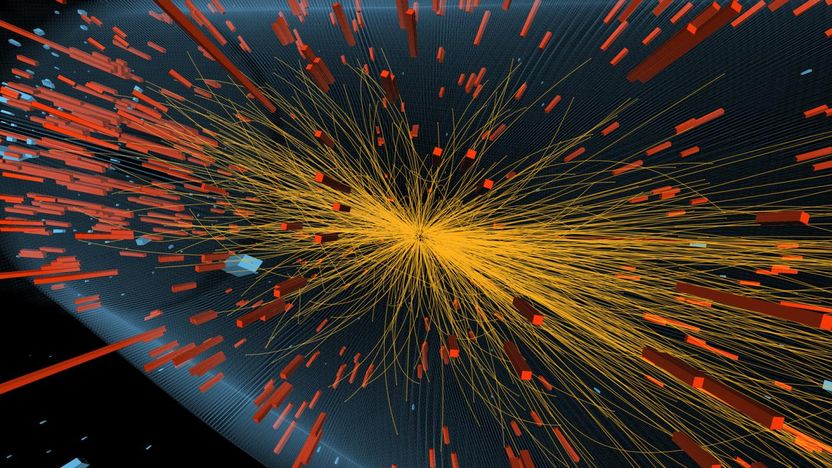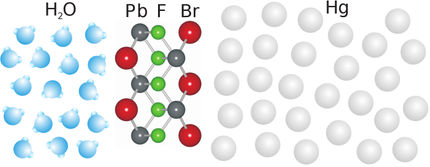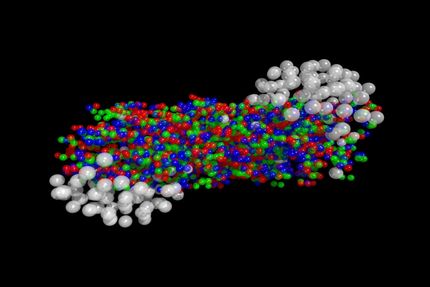Largest atom smashers create smallest droplets
How small can a droplet shrink and still remain a liquid?
Advertisement
The LHC successfully created sub-atomic blobs of quark-gluon-plasma (QGP) by colliding lead ions together. Smashing these two massive ions together generated tremendous temperatures, that are required for the primordial state of matter to form.

This is a aiagram of a proton-lead collision in the Large Hadron Collider that produced a drop of quark-gluon plasma about one-tenth the size of those produced in previous experiments.
Large Hadron Collider/CMS
“Lead ions are very large, each containing hundreds of protons and neutrons. When you smash them together at very high speed, they generate blobs of plasma that produce thousands of particles when they cool down,” said Professor of Physics Julia Velkovska at Vanderbilt University. “But in 2013 when the LHC switched to collisions between individual protons and lead ions, we didn’t think the collisions would contain enough energy to produce any plasma.”
However, post-doctoral fellow Shenguan Tuo began making detailed measurements of the behavior of the particles produced by these smaller proton-lead collisions as part of his doctoral thesis and discovered that they were in fact producing liquid droplets that were about one tenth the size of those produced in the lead-lead collisions.
“Everyone was surprised when we began finding evidence for liquid behavior,” said Tuo. “It caused some very intense debates.”
Flowing particles
One of the key properties of a liquid is the ability to flow, which means that each particle is exerting an attractive force on its neighbors that is strong enough to effect their movement. So their movements are coordinated and, when released from a container, they retain information about the container’s shape. Tuo’s measurements showed that small numbers of particles produced in the proton-lead collisions originated on the ellipsoidal surfaces of small QGP droplets.
Because of the computational difficulty involved, physicists normally look for these correlations between pairs of particles, but Velkovska, Tuo and their CMS collaborators took it several steps further. In some cases, they went to the extraordinary length of computing the correlations between all the particles in a given collision.
“These measurements confirmed that we were seeing this coherent behavior even in droplets producing as few as 100 to 200 particles,” Tuo said.
Gold ions led to discovery
To see what happened at even higher energies, the Vanderbilt group joined the CMS science team at the LHC located at the European Laboratory for Nuclear and Particle Physics in Geneva. The more powerful particle collider succeeded in duplicating the RHIC results, first as expected, by smashing lead ions together and then, unexpectedly, in the proton-lead collisions.
The proton-lead results prompted the scientists in the PHENIX team to re-analyze data that had been collected at RHIC in 2008, when the collider had smashed deuterium ions and gold ions together at much lower energies than those in the LHC. The re-analysis, led by assistant research professor Shengli Huang at Vanderbilt University, found that the proton-neutron pairs formed two hot spots in the gold ion when they collided which then merged into an elongated drop of QGP.
The RHIC researchers decided to test this further by adding a new run that collided helium ions with gold ions, and found that the same thing happened, except that three hot spots formed and merged into the QGP droplet. The results were just published in Physical Review Letters.
“Although the LHC collisions release 25 times more energy than the RHIC collisions, we don’t see much difference in the droplet-formation process: Once you have reached the threshold, adding more energy doesn’t seem to have much effect,” said Velkovska. “I guess you can’t get more perfect than perfect!”
Perfect liquid
Not only have the physicists found that the quark-gluon plasma is a liquid, the physicists have also established that it is nearly a perfect liquid, which means it is a liquid with zero viscosity that flows without any resistance. If you swish a perfect liquid in a glass and set the glass down, then the liquid will continue to swirl around as long as it is not disrupted.
Curiously, the phenomenon that most closely resembles the properties of the hottest known liquid is one of the coldest known liquids: lithium atoms that have been cooled to temperatures one-billionth of a degree above absolute zero using a device called a laser trap. When released from the trap these ultra-cold atoms also behave as a perfect liquid with near-zero viscosity.
“These are both strongly coupled systems. This appears to be an emergent property of such systems,” Velkovska has concluded.


































































